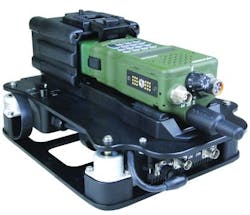SANTA CLARA, Calif., 5 May 2011. The 2nd Generation Intel Core i7 microprocessor architecture, on which aerospace and defense embedded computing designers have come to depend for the latest complex digital signal processing (DSP) applications, is about to see major improvements in performance and power consumption with the introduction Wednesday of volume production for Intel's 3D Tri-Gate microprocessor technology.Tri-Gate technology seeks to shrink chip size and increase transistor density with a three-dimensional design that abandons the traditional two-dimensional planar transistor structure that has dominated microprocessor design since the invention of the integrated circuit half a century ago, Intel officials say. The company will manufacture Tri-Gate technology on a 22-nanometer chip fabrication line, and has code-named the new chip technology Ivy Bridge.The first high-volume Intel microprocessors to be manufactured with the Ivy Bridge Tri-Gate technology will be the Intel Core family. Production of these chips should begin by the end of this year, Intel officials say. Aerospace and defense systems designers prefer the Intel Core i7 processor because of its combined floating-point- and graphics-processing capabilities, which are particularly useful in sensor- and signal-processing applications in radar, sonar, electronic warfare, signals intelligence, and other DSP-intensive systems.
The next generation of Tri-Gate Ivy Bridge-based Core i7 processors will operate at lower voltages with lower leakage than the current generation of the Core i7, and will have better performance and energy efficiency, Intel officials say. Designers will continue to have the ability to choose between low power or high performance, based on the requirements of their applications.
The new chips will have performance increases of as much as 37 percent over current-generation Core i7s, and will consume about half the power, Intel officials say. These qualities will make the Tri-Gate Ivy Bridge Core i7 processors even more attractive for size, weight, and power (SWaP)-constrained aerospace applications such as hand-held devices, soldier-worn systems, and unmanned vehicles.
For more information contact Intel online at www.intel.com.
